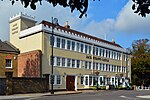Heath House is a historic mansion on Hampstead Heath. It is Grade II* listed and located on Hampstead's North End Way in the London Borough of Camden.From 1790 Heath House was the London seat of banker and philanthropist Sir Samuel Hoare and remained in the family until the house was badly damaged in the Second World War and was sold. It subsequently remained largely unoccupied and deteriorated since it left the Hoare family's ownership. It was bought by Donald Forrester who undertook a major renovation on the building and the grounds. It then became a Forrester family home for several years. The house has also been associated with Elizabeth Fry, who married a son of the house (Samuel Hoare) and William Wilberforce with whom the Hoare family fought for abolition of slavery.There are several branches of the Hoare family which have been involved in the city (for example those connected with the broking firm Hoare Govett, or those connected with the small private bank C. Hoare & Co) who are only most distantly related. The Quaker branch of the family (the residents of Heath House) is the one which played a significant part in philanthropy and public life, for example in the movement for abolition of slavery by co-founding The Society for the Abolition of the Slave Trade and several members of the family were also members of Parliament, including Sir Samuel Hoare, 1st Baronet who held the Norwich seat, his son Sir Samuel Hoare, who was Foreign Secretary, Home Secretary and was created Viscount Templewood and Edward Brodie Hoare, who held the Hampstead seat.
In the banking world the family bank, Barnett Hoare & Co of Lombard Street was one of the city's most prestigious merchant banks which eventually merged with Lloyds Bank, with the combined bank retaining the Lloyds name and adopting the Barnett Hoare logo of the black horse (which is still in use as of 2016). Edward Hoare, the senior member of the bank at the time of the merger, served as deputy chairman of Lloyds following the merger.
A younger brother of Samuel Hoare Jr, Jonathan Hoare had another significant mansion in a London park built for himself, namely Paradise House, now known as Clissold House (open to the public) in Clissold Park, Stoke Newington.
From 1971 to 1977 Heath House was the home of Peter King, owner of Screen International (King Publications). It was sold in 1977 to property owner John Sunley and then acquired in 1979 by a prominent Saudi Arabian family. Over the last few decades, with changes of ownership, Heath House has fallen into a state of disrepair. Planning applications to convert the derelict building into flats were rejected in 2019. Heath House remains clad in scaffolding to preserve its exterior until a decision is made about its future.
The Hampstead War Memorial stands in front of the house.












